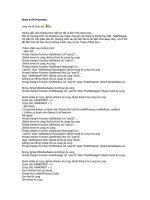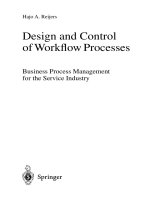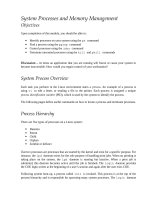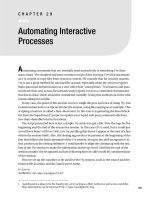Photocopying Processes
Bạn đang xem bản rút gọn của tài liệu. Xem và tải ngay bản đầy đủ của tài liệu tại đây (2.03 MB, 96 trang )
P
P
h
h
o
o
t
t
o
o
c
c
o
o
p
p
y
y
i
i
n
n
g
g
P
P
r
r
o
o
c
c
e
e
s
s
s
s
e
e
s
s
Overview
1. Scanning
An exposure lamp illuminates the original. Light reflected off the original is used to create the
image on a drum*. In analog machines, the light is reflected through a series of mirrors,
eventually striking the drum directly. For multi-copy runs, the original must be scanned for each
copy.
In digital machines, the reflected light is passed to a CCD or CIS, where it is converted into an
analog data signal. This data is further converted to a digital signal, processed, and stored in
memory. To print, the data is retrieved and sent to a laser diode. For multi-copy runs, the original
is scanned only once and stored to a hard disk.
* In this overview section we refer to the photoconductor as a drum just for simplicity. However, be aware that the
photoconductor is often an OPC belt rather than a drum.
Overview
Charge
Exposure
Development
Transfer and Separation
Cleaning
Quenching
Fusing
1
1 April 2001 Page 90
Photocopying Processes Overview
2. Charging
A charge is applied to the
photoconductor drum. There are a
variety of methods for this. Some
machines apply a positive charge,
others apply a negative. Most use a
non-contact corona wire—though
some use a contact, charge roller.
The drum holds the charge because
the photoconductive surface of the
drum has a high electrical
resistance–unless exposed to light.
3. Exposure
In an analog machine, the light
reflected off the original is redirected
to the drum. In a digital machine, the processed data from the scanned original is retrieved from
memory or from a hard disk and transferred to the drum by one or more laser beams. In both
cases, the areas exposed to light lose some or all of their charge. This writes an electrostatic
image on the drum.
8
7
6
5
4
3
2
1 April 2001 Page 91
Photocopying Processes Overview
4. Development
Toner is attracted to the latent image on the drum. The exact process varies depending on
whether the drum holds a positive or negative charge. Most analog machines are Write to
White—the toner is attracted to unexposed areas on the drum. Most digital machines are Write to
Black—the toner is attracted to exposed areas.
5. Transfer
The image is transferred to paper. Some machines transfer the image directly from the drum.
Others use an intermediary transfer belt. Transfer belts are particularly common in color
machines. The four colors are layered onto the belt, and then the final image is transferred to the
paper in one step.
6. Separation
The paper can be separated from the drum (or image transfer belt) electrostatically or
mechanically. Charge coronas, discharge plates, pick-off pawls and sharply curved paper paths
are all used. Often a machine will combine two or more methods.
7. Cleaning
The remaining toner is cleaned off the drum. Most machines use a cleaning blade to wipe off the
excess toner. Some add a cleaning brush or cleaning roller to improve efficiency.
8. Quenching
Light from a lamp neutralizes the remaining charge on the drum’s surface.
1 April 2001 Page 92
Photocopying Processes
[A]
[B]
9. Fusing
Heat and pressure are used to melt the toner and
attach it to the page. The hot roller [A] is usually
heated by one or more halogen lamps. The
pressure roller [B] may or may not be heated.
Charge
Overview
Charge refers to the application of a uniform electrostatic charge to a photoconductor in darkness. At
present, two kinds of electrostatic charge methods are widely used in Ricoh products. The most
common is the corona electrostatic charge method (non-contact type), which takes advantage of the
corona discharge produced when a high voltage is applied to a fine wire. The other is the
electrostatic charge roller method (contact type), which provides an electrostatic charge by applying a
high voltage to a roller and contacting the roller to the photoconductor.
9
1 April 2001 Page 93
Photocopying Processes Charge
Corona Charge
Corotron Method—Positive charge (Se)
A power pack applies several thousand volts of
electricity to a charge wire and a corona discharge is
generated from the charge wire. The corona discharge
ionizes air particles and the positive ions concentrate
around the charge casing and photoconductive surface
(Selenium). The photoconductor (insulator in darkness)
stops the positive ions. The positive ions induce a
negative electrostatic charge in the aluminum base,
retaining the electrostatic charge.
Scorotron Method—Negative charge (OPC)
When several thousand volts of electricity are
applied to a charge wire [A], a corona discharge is
generated from the charge wire. The corona
discharge ionizes air particles and the negative
ions concentrate around the charge casing [B] and
grid [C]. The negative ions adhere to the photo-
conductor [D] (insulator in the darkness), causing
positive electrostatic charge in the aluminum base
[E], retaining the electrostatic charge.
[A]
[B]
[C
[D]
[E]
050102.pcx
050101.pcx
1 April 2001 Page 94
Photocopying Processes Charge
[B]
[C]
[A]
chrggrid.pcx
Scorotron Grid
The quantity of the current of discharged
electricity along the wire length changes as shown
by the chart on the right. As this suggests, a
negative corona is less uniform than a positive
corona.
Therefore, the scorotron method uses a grid to
even out the electric potential on the
photosensitive surface.
The grid is located at +1 or +2 millimeters away
from the photosensitive surface, and the grid
material is either stainless steel or tungsten wire.
[A]: Grid
[B]: Power pack
[C]: Drum
050103.pcx
Corona
output
Effect
of grid
1 April 2001 Page 95
Photocopying Processes Charge
Corona Charge Power Pack
A rated current power pack is used for corona charging. In comparison to a rated voltage power
pack, a rated current power pack provides a more stable image quality. It does this by stabilizing the
total wire current even when the charge wire deteriorates or the wire resistance increases due to
staining caused by dust.
Uneven Charge Prevention
To prevent an uneven build-up of charge on the
photoconductor, a flow of air is supplied to the
electrostatic charge section. In the machine
illustrated (model A184), the exhaust fan [A]
causes a flow of air through the charge corona
section.
Generally, an ozone filter [B] is also installed in
the charge section to adsorb ozone (O3)
generated by the charge corona.
[A]
[B]
1 April 2001 Page 96
Photocopying Processes Charge
Charge Roller Method
An electrostatic charge is applied to the photoconductor by applying several thousand volts of
electricity to the drum charge roller [A]. The drum charge roller contacts the surface of the OPC drum
[B] to give a negative charge
The DC power pack [C] for the electrostatic charge is a constant voltage type. This is because, in
comparison to constant current power packs commonly used for coronas, the constant voltage type
is better able to supply a uniform electrostatic charge on the drum surface when using a roller.
The amount of ozone generated during drum charging is much less than the amount made by a
corona wire scorotron system. Therefore, there is no need for an ozone filter
[A]
[B]
[C]
mo6.wmf
1 April 2001 Page 97
Photocopying Processes Charge
Drum Charge Roller Construction
The charge roller consists of a steel core,
surrounded by layers of rubber and other
material.
Charge Roller Cleaning
If the charge roller becomes dirty, uneven charge may be applied to the photoconductor. This would
decrease drum charge efficiency and cause spots and streaks on the output image. For this reason,
the charge roller must be cleaned.
The charge roller cleaning may be done periodically (see example 1) or, if space is limited, the
cleaning pad may be constantly in contact with the charge roller (example 2).
Outer Layer:
Hydrin,
Fluorine com-
pound, Silica
Inner Layer:
Epichlorohydrin
Rubber
Steel Core
1 April 2001 Page 98
Photocopying Processes Charge
Example 1: Model A193—Contact and release
This machine has a contact and release
mechanism with which it cleans the charge roller
periodically.
Drum charge roller cleaning is done for 2 seconds
after every copy job. After the copy job, the charge
roller contact clutch is driven another third of a
rotation. The pressure lever presses down more,
so that the cleaning pad [A] contacts the charge
roller.
After charge roller cleaning, the clutch is driven
the final third of the rotation (until the charge roller
H.P sensor [B] is activated) to release the charge
roller from the drum. The pressure lever moves
away from the charge roller unit. Then the charge
roller unit is released from the drum by the springs
[C].
A193D544.wmf
[B]
[A]
[C]
A193D015.wmf
[A]
1 April 2001 Page 99
Photocopying Processes Charge
Example 2: Model A230/A231/A232—Constant contact
Because the drum charge roller [A] always contacts the drum, it gets dirty easily. So, the cleaning
pad [B] also contacts the drum charge roller all the time to clean the surface of the drum charge
roller.
The pin [C] at the rear of the cleaning pad holder rides on the cam [D] on the inside of the gear. This
cam moves the cleaning pad from side to side as the gear turns. This movement improves cleaning
efficiency.
[B]
[C]
[D]
[A]
A230D303.WMF
1 April 2001 Page 100
Photocopying Processes Exposure
Exposure
Overview
Exposure refers to a process where light is applied to a photoconductor to create a latent reverse
image in the form of a charge pattern on the surface of the photoconductive material. Depending
on the brightness of the image, the electric potential on the photoconducutor’s surface is attenuated;
thus, forming an electrostatic latent image
Ricoh products use three main exposure methods—flash exposure, strip exposure (sometimes
called slit exposure), and laser exposure. The analog methods—flash and strip exposure—are
covered in this chapter. Strip exposure is further divided into exposure using moving optics and
exposure with fixed optics. Laser exposure is covered in the Digital Processes chapter
Strip Exposure With Moving Optics
Strip exposure with moving optics scans a strong light source across a fixed original. The strip of the
image illuminated during this scanning, is continuously projected to the photoconductor by an optical
assembly (mirrors and lens).
This method makes it easy to obtain even illumination distributions and it is well suited to projecting
images onto cylindrical drums. Also, it is easy to change magnification by repositioning the optical
components. However, it has speed limitations. Due to these characteristics, strip exposure is the
most common exposure method used for low and medium speed models.
1 April 2001 Page 101
Photocopying Processes Exposure
Example: Models A095/A096/A097
The illustration to the right shows the optics unit of
the A095 series. This copier uses six mirrors to
“fold” the optic path and thus make the optics unit
smaller and obtain a wide reproduction ratio range
(50 ~ 200%). A halogen lamp [A] mounted in the
scanner is the light source. The 3
rd
and 4
th
mirror
carrier [B] moves at half the speed of the scanner
to maintain a constant optical distance between
the original and the lens [C] during scanning. The
lens and the 4
th
and 5
th
mirrors [D] can be
repositioned to change the reproduction ratio. A
toner shield glass prevents toner and paper dust
from leaking through the exposure slit into the
optics cavity.
stripexp.wmf
[A]
[D]
[B]
[C]
1 April 2001 Page 102
Photocopying Processes Exposure
Scanner Drive
Here we will look at a couple of examples
of scanner drive mechanisms in analog
machines.
The illustration to the right shows a typical
drive mechanism for an analog process
photocopier. (Model A095)
A dc servomotor is used as the scanner
drive motor [A]. Scanner drive speed
during scanning depends on the
reproduction ratio. For a 100% copy, the
scanning speed is 330mm/s.
The scanner drive motor drives the first
[B] and second scanners [C] using two
scanner drive wires via the timing belt [D]
and the scanner drive shaft [E]. The
second scanner speed is half of the first
scanner speed. The scanner drive wire is
not directly wound around the pulley on
the scanner drive motor.
scandrv1.pcx
1 April 2001 Page 103
Photocopying Processes Exposure
The second scanner drive example (model A219) shows scanner drive using belts rather than wires.
A stepper motor [A] drives the scanners. The first scanner [B], which consists of the exposure lamp
and the first mirror, is connected to the first scanner belt [C]. The second scanner [D], which consists
of the second and third mirrors, is connected to the second scanner belt [E]. Both the scanners move
along the guide rod [F].
A219D522.wmf
[B]
[C]
[D]
[E]
[F]
[G]
[H]
[A]
1 April 2001 Page 104
Photocopying Processes Exposure
There are no scanner drive wires, and only one side of the scanner is supported (by a rod and guide
rail).
The pulley [G] drives both the first and second scanner belts. The 2nd scanner moves at half the
speed of the first scanner. This maintains the focal distance between the original and the lens during
scanning.
The scanner home position is detected by a home position sensor [H]. The scanner return position is
determined by counting the scanner motor drive pulses.
1 April 2001 Page 105
Photocopying Processes Exposure
Lens Drive
For a copier to make reduced or enlarged
copies, the lens must be moved to achieve
the proper optical distance between the lens
and the drum surface for the selected
reproduction ratio.
There are many ways this can be done. The
illustration (from model A152) shows a typical
arrangement. In this case, a stepper motor
[A] changes the lens [B] position through the
lens drive wire [C].
The rotation of the lens drive pulley moves
the lens back and forth in discrete steps. The
home position of the lens is detected by the
home position sensor [D]. The main board
keeps track of the lens position based on the
number of pulses sent to the lens motor.
lensdrv1.pcx
1 April 2001 Page 106
Photocopying Processes Exposure
Mirror Positioning
To make reduced or enlarged copies, it isn’t
enough to just move the lens. To maintain focus,
analog copiers must move mirrors also. For the
typical 6-mirror exposure system, the 4th/5th mirror
assembly is repositioned. (This is sometimes
referred to as “third scanner drive”; however, that
actually isn’t an accurate name because the
mirrors are stationary during scanning.)
The illustrations to the right show two examples. In
the upper illustration, a stepper motor [A] changes
the 4th/5th mirror assembly position through a rack
and pinion drive system [B].
The lower illustration shows a system where the
mirror assembly is repositioned using a drive belt
[C].
A171D567.pcx
[C]
A219D510.wmf
[B]
[A]
1 April 2001 Page 107
Photocopying Processes Exposure
Strip Exposure With Fixed Optics
Strip exposure with fixed optics is a system
where the original moves and the optics and
light source are fixed. A strip of the original
image is illuminated as it moves past the optics,
and the optics continuously project this strip
image to the photoconductor. While several
types of optics could be used for this system,
Ricoh uses a SELFOC fiber optic array. The
fiber optic array has the advantage of being very
compact. For that reason it is used mostly in
large format copiers, where lens and mirror
optics are impractical, and in small, low speed
personal copiers, where compact size is
important.
Original document
SELFOC fiber optic array
Exposure image
ips138.wmf
1 April 2001 Page 108
Photocopying Processes Exposure
Example: Model A174 (Whale)
The illustration to the right shows the exposure
mechanism of the model A174.
Light from the exposure lamp [A] reflects off the
original and through the fiber optics [B] to the
OPC drum [C]. During exposure, the original
moves across the exposure glass at the same
speed as the drum’s peripheral velocity.
The platen roller [D] presses the original [E] flat
against the exposure glass [F] just above the
fiber optic array. This ensures that the image is
properly focused. (The original must be within
0.2 mm of the exposure glass surface.)
The exposure lamp is a fluorescent lamp.
a174d505.wmf
[A]
[B]
[C]
[D]
[E]
[F]
1 April 2001 Page 109
Photocopying Processes Exposure
Flash Exposure
Flash exposure is an overall exposure method, which
projects the document image onto the photoconductor,
by exposing the entire document surface at once. As
this method does not require a scanning mechanism, it
enables high speed copying. However, it requires the
photoconductor’s surface to be flat and it requires an
optics cavity that is quite large compared to standard
scanner optics.
Example: Models A112/A201 (Big Bird)
The illustration to the right shows the exposure
mechanism of the FT9101/9105. A xenon flash lamp
[A] illuminates the entire document in a single flash of
light. The flash is of such short duration (170 ms) that
the opc belt [B], which moves at 430 mm/s, does not
have to stop during exposure.
Reflectors [C] provide even light intensity to the
original. Even though mirrors [D] are used to ‘fold’ the
light path, most of the interior of the main body of the
copier is taken up by the optics cavity.
IPS165.wmf
[A]
[C]
[B]
[D]
1 April 2001 Page 110
Photocopying Processes Exposure
Exposure Lamp Control
Fluorescent Lamp
Feedback Control System
Light from a fluorescent lamp tends to
fluctuate. For this reason, exposure lamp
intensity must be stabilized during the copy
cycle to get a constant latent image on the
drum. To accomplish this the actual light
output by the lamp is fed back to a control
circuit.
The illustration to the right (from model
A171) shows a typical control system. The
main PCB [A] monitors the light intensity
through a fiber optics cable [B]. based on
this input, a lamp power signal (pulse width
modulated signal) is sent to the fluorescent
lamp regulator [C].
A171D572.pcx
[B]
[C]
[A]
1 April 2001 Page 111
Photocopying Processes Exposure
Fluorescent Lamp Regulator
The fluorescent lamp regulator (also called
“FL stabilizer”) converts the power input to a
stable, high-frequency ac output to the
fluorescent lamp. A fluorescent lamp
operates more efficiently with high
frequency power input.
The percentage of the time that the lamp
receives power—the duty cycle—is
controlled by a pulse width modulated
control signal.
In the illustration to the right (from model
A163), the lamp regulator [A] receives 24
volts dc at CN401-1 from the PSU [B]. The
control signal, which is a pulse width
modulated (PWM) signal, is received at
CN401-4. The PWM signal has a period (T)
of 1 millisecond and a duty ratio of 15% to
100%.
FL_regulator.pcx
1 April 2001 Page 112
Photocopying Processes Exposure
explamp1.pcx
explamp2.pcx
Halogen Lamp
The illustration to the right (from model
A110) shows a typical control circuit for
a
halogen lamp
used for exposure.
The main board sends lamp trigger
pulses to the ac drive board from
CN122-7. PC401 activates TRC401,
which provides ac power to the expo-
sure lamp, at the trailing edge of each
trigger pulse.
The voltage applied to the exposure
lamp is also provided to the feedback
circuit. The feedback circuit steps
down (TR401), rectifies (DB401), and
smoothes (zener diodes and capacitors) the lamp voltage. The
CPU monitors the lowest point of the smoothed wave (feedback
signal), which is directly proportional to the actual lamp voltage.
The CPU changes the timing of the trigger pulses in response to
the feedback voltage. If the lamp voltage is too low, the CPU
sends the trigger pulses earlier so that more ac power is applied
to the exposure lamp. This feedback control is performed
instantly; so, the lamp voltage is always stable even under
fluctuating ac power conditions
.
1 April 2001 Page 113
Photocopying Processes Development
Development
This section covers standard systems for latent image development that are commonly used in Ricoh
products. These development systems are divided into the dual-component development method
and the mono-component development method.
Dual-Component Development (Magnetic Brush)
Overview
The two-component development process uses
developer made of mixed toner [A] and carrier [B]. These
two components rub against each other in the develop-
ment unit and take on opposite charges. When a
selenium photoconductor (drum) [C] is used, the toner
takes a negative charge and the carrier takes a positive
charge.
The carrier consists of resin-coated metallic particles, and
they align with magnetic lines of force from magnets [D]
inside the development roller, [E] forming a magnetic
brush. The rotating drum contacts the magnetic brush,
and the charged latent image areas of the drum attract
the oppositely charged toner particles.
[A]
[E]
[D]
[C]
[B]
magbrush.pcx
1 April 2001 Page 114









